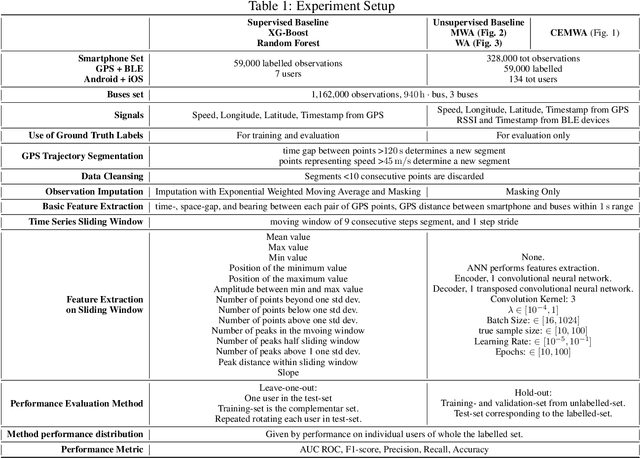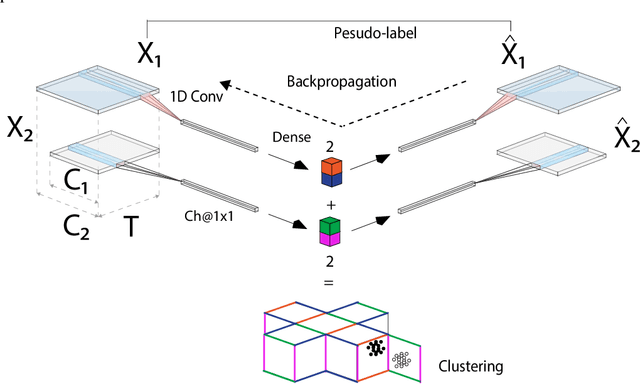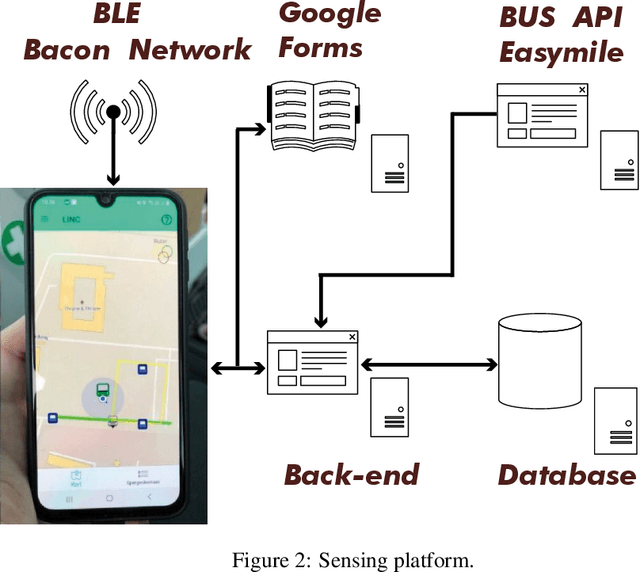Hannah Villadsen
Large Scale Passenger Detection with Smartphone/Bus Implicit Interaction and Multisensory Unsupervised Cause-effect Learning
Feb 24, 2022



Abstract:Intelligent Transportation Systems (ITS) underpin the concept of Mobility as a Service (MaaS), which requires universal and seamless users' access across multiple public and private transportation systems while allowing operators' proportional revenue sharing. Current user sensing technologies such as Walk-in/Walk-out (WIWO) and Check-in/Check-out (CICO) have limited scalability for large-scale deployments. These limitations prevent ITS from supporting analysis, optimization, calculation of revenue sharing, and control of MaaS comfort, safety, and efficiency. We focus on the concept of implicit Be-in/Be-out (BIBO) smartphone-sensing and classification. To close the gap and enhance smartphones towards MaaS, we developed a proprietary smartphone-sensing platform collecting contemporary Bluetooth Low Energy (BLE) signals from BLE devices installed on buses and Global Positioning System (GPS) locations of both buses and smartphones. To enable the training of a model based on GPS features against the BLE pseudo-label, we propose the Cause-Effect Multitask Wasserstein Autoencoder (CEMWA). CEMWA combines and extends several frameworks around Wasserstein autoencoders and neural networks. As a dimensionality reduction tool, CEMWA obtains an auto-validated representation of a latent space describing users' smartphones within the transport system. This representation allows BIBO clustering via DBSCAN. We perform an ablation study of CEMWA's alternative architectures and benchmark against the best available supervised methods. We analyze performance's sensitivity to label quality. Under the na\"ive assumption of accurate ground truth, XGBoost outperforms CEMWA. Although XGBoost and Random Forest prove to be tolerant to label noise, CEMWA is agnostic to label noise by design and provides the best performance with an 88\% F1 score.
"Is not the truth the truth?": Analyzing the Impact of User Validations for Bus In/Out Detection in Smartphone-based Surveys
Feb 24, 2022



Abstract:Passenger flow allows the study of users' behavior through the public network and assists in designing new facilities and services. This flow is observed through interactions between passengers and infrastructure. For this task, Bluetooth technology and smartphones represent the ideal solution. The latter component allows users' identification, authentication, and billing, while the former allows short-range implicit interactions, device-to-device. To assess the potential of such a use case, we need to verify how robust Bluetooth signal and related machine learning (ML) classifiers are against the noise of realistic contexts. Therefore, we model binary passenger states with respect to a public vehicle, where one can either be-in or be-out (BIBO). The BIBO label identifies a fundamental building block of continuously-valued passenger flow. This paper describes the Human-Computer interaction experimental setting in a semi-controlled environment, which involves: two autonomous vehicles operating on two routes, serving three bus stops and eighteen users, as well as a proprietary smartphone-Bluetooth sensing platform. The resulting dataset includes multiple sensors' measurements of the same event and two ground-truth levels, the first being validation by participants, the second by three video-cameras surveilling buses and track. We performed a Monte-Carlo simulation of labels-flip to emulate human errors in the labeling process, as is known to happen in smartphone surveys; next we used such flipped labels for supervised training of ML classifiers. The impact of errors on model performance bias can be large. Results show ML tolerance to label flips caused by human or machine errors up to 30%.
 Add to Chrome
Add to Chrome Add to Firefox
Add to Firefox Add to Edge
Add to Edge